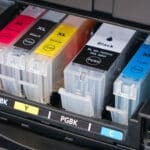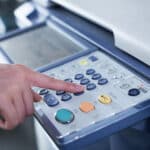
As individuals and businesses strive to cut down their carbon footprint, sustainable printing methods are gaining popularity. Thanks to recent technological advances, suppliers can now produce high-quality prints sustainably. It is essential for any business that wants to demonstrate its commitment towards environmental responsibility to know what sustainable printing options are available today – here’s a list of the five most advanced ones!
1. LED UV Printing
When you’re looking to make a lasting impression, LED UV printing is your best option for brochures, booklets, leaflets and promotional material. With its superior ultraviolet light instant drying process, colors remain bright and designs stay razor sharp- perfect for when you need to stand out!
LED UV printing is a remarkably eco-friendly method of printing. It uses significantly less energy than traditional print drying technology, and its instantaneous on/off feature limits standby power consumption between jobs and reduces carbon dioxide emissions. Additionally, the rapid drying process eliminates the need for anti-set off powder spraying or sealing coats.
2. Recycled Paper 101
With the various paper and stock options available, it can be difficult to understand which printing techniques are truly sustainable. Thankfully, this guide will help make things more transparent. We’ve been conditioned to think that only recycled papers should be used in order to promote eco-friendliness; however, new fibres from freshly cut trees are essential for keeping up the paper cycle alive and well. Without them, a lasting sustainability would not be achievable!
In order to maintain a sustainable cycle of paper production, recycled fibres are required to be replenished after several uses. As long as the new fibers come from responsibly-managed forests, it is both safe and beneficial for you to use either virgin paper or recycled paper.
3. Digital Printing
Digital printing does not require a printing plate, making it an incredibly efficient and waste-free process. This is especially beneficial for smaller print runs that may only need hundreds of prints; digital printing can be done quickly with just the ink sitting on top of the substrate! Not to mention, machines are capable of churning out up to 4,800 sheets per hour once they start – which makes it cost effective too.
4. Carbon Balanced Paper and Print
By utilizing Carbon Balanced Paper, your printer is ensuring that the entire paper production and mill delivery process releases an average CO2 offset. Printing suppliers are providing their clients with a sustainable choice for any print job by offering this eco-friendly stock option.
Carbon Balance Printers take sustainability to the next level by assessing the entire company’s CO2 output and investing in methods that can prevent or even reverse those emissions. Furthermore, these printers are continuously striving to make their processes more sustainable while still reducing their carbon footprint each year. When all feasible measures have been taken and any remaining unavoidable carbon is offset, they will attain true Carbon Balanced Print standards.
5. Uncoated Paper
When you use uncoated paper for LED UV printing, the results are unparalleled. But even more noteworthy is its recyclability – this presents an advantage to both sustainability and convenience due to its lightweight fiber composition. Uncoated paper makes it easier than ever before to transport materials directly into a mill’s recycling process, making eco-friendly printing practices simpler than ever before!





